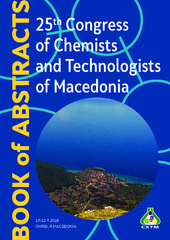Приказ основних података о документу
Electrophysical properties of nonwoven viscose/polypropylene fabrics
| dc.creator | Cerović, Dragana D. | |
| dc.creator | Asanović, Koviljka | |
| dc.creator | Kostić, Mirjana | |
| dc.creator | Mihailović, Tatjana V. | |
| dc.creator | Ivanovska, Aleksandra | |
| dc.creator | Maletić, Slavica | |
| dc.date.accessioned | 2023-11-09T12:54:07Z | |
| dc.date.available | 2023-11-09T12:54:07Z | |
| dc.date.issued | 2018 | |
| dc.identifier.isbn | 978-9989-760-16-7 | |
| dc.identifier.uri | http://TechnoRep.tmf.bg.ac.rs/handle/123456789/6794 | |
| dc.description.abstract | Textile materials like woven, knitted and nonwoven fabrics are good insulators with very high electrical resistance. It is known that dielectric properties (effective dielectric permeability, electrical conductivity, and dielectric loss tangent) and electrical resistivity (volume resistivity and surface resistivity) of fabric are depending on several factors such as fiber type, fabric structure, moisture content of the material, air humidity, temperature, etc. The purpose of this investigation is to study the influence of the different content of viscose and polypropylene as well as the type of web bonding on the dielectric loss tangent and volume electrical resistivity. Also, the dielectric loss tangent was analyzed over a range of frequencies from 30 Hz to 140 kHz. Three investigated nonwoven fabrics were mechanically and thermally bonded, and one of the samples was additionally chemically bonded. The investigations were realized at 40 % relative air humidity. Conducted analyses show that at frequencies below 100 Hz all investigated samples have higher, while at higher frequencies, the investigated samples show lower values of loss tangent. Namely, gradually decrease of the loss tangent value with the increase in the frequency from 30 Hz to 140 kHz was registered. The highest loss tangent value shows the sample with the highest viscose fiber content and thus the highest number of polar hydroxyl groups. The smallest loss tangent value was registered for a sample which was additionally chemically bonded. Results obtained for the volume electrical resistivity was in accordance with the loss tangent values. The lowest resistivity value was recorded for sample with the highest viscose fiber content both in the machine direction as well as in the cross direction (5.27 GΩ∙cm and 5.03 GΩ∙cm, respectively), while the highest resistivity value was registered for additionally chemically bonded sample also in both investigated direction (11.84 GΩ∙cm and 12.51 GΩ∙cm, respectively). Some little differences in volume electrical resistivity in the machine and in cross direction are probably due to the fiber orientation in the samples and the number of contacts established between the fibers, because better contact between fibers causes an easier flow of charge. | sr |
| dc.language.iso | en | sr |
| dc.publisher | Skopje : Society of chemists and technologists of Macedonia | sr |
| dc.relation | info:eu-repo/grantAgreement/MESTD/Basic Research (BR or ON)/171029/RS// | sr |
| dc.relation | info:eu-repo/grantAgreement/MESTD/Basic Research (BR or ON)/172029/RS// | sr |
| dc.rights | openAccess | sr |
| dc.rights.uri | https://creativecommons.org/licenses/by/4.0/ | |
| dc.source | Book of abstracts / 25th Congress of the society of chemists and technologists of Macedonia (with international participation) 19-22 September 2018 Ohrid, R. Macedonia | sr |
| dc.subject | viscose/polypropylene | sr |
| dc.subject | dielectric loss tangent | sr |
| dc.subject | volume electrical resistivity | sr |
| dc.subject | nonwoven fabrics | sr |
| dc.title | Electrophysical properties of nonwoven viscose/polypropylene fabrics | sr |
| dc.type | conferenceObject | sr |
| dc.rights.license | BY | sr |
| dc.citation.spage | 257 | |
| dc.identifier.fulltext | http://TechnoRep.tmf.bg.ac.rs/bitstream/id/18464/Electrophysical_properties_pub_2018.pdf | |
| dc.identifier.rcub | https://hdl.handle.net/21.15107/rcub_technorep_6794 | |
| dc.type.version | publishedVersion | sr |

